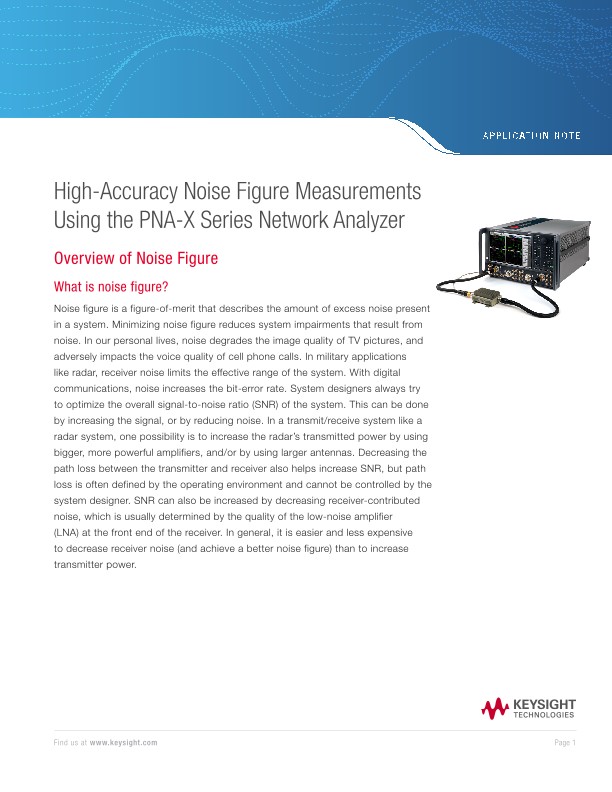
High-Accuracy Noise Figure Measurements with Network Analyzers
Application Notes
Overview of Noise Figure
What is noise figure?
Noise figure is a figure-of-merit that describes the amount of excess noise present in a system. Minimizing noise figure reduces system impairments that result from noise. In our personal lives, noise degrades the image quality of TV pictures and adversely impacts the voice quality of cell phone calls. In military applications like radar, receiver noise limits the effective range of the system. With digital communications, noise increases the bit-error-rate. System designers always try to optimize the overall signal-to-noise ratio (SNR) of the system. This can be done by increasing the signal, or by reducing noise. In a transmit/receive system like a radar system, one possibility is to increase the radar’s transmitted power by using bigger, more powerful amplifiers, and/or by using larger antennas. Decreasing the path loss between the transmitter and receiver also helps increase SNR, but path loss is often defined by the operating environment and cannot be controlled by the system designer. SNR can also be increased by decreasing receiver-contributed noise, which is usually determined by the quality of the low-noise amplifier (LNA) at the front end of the receiver. In general, it is easier and less expensive to decrease receiver noise (and achieve a better noise figure) than to increase transmitter power.
Table of Contents:
- Overview of Noise Figure
- What is noise figure?
- Importance of noise figure accuracy
- Noise Figure Measurement Techniques
- Y-factor method
- Cold source method
- Accuracy Limitations
- Assumptions of the Y-factor method
- Noise figure measurement uncertainty contributions
- PNA-X’s Unique Approach
- Option choices
- Correcting for noise-parameter effects
- Measurement comparisons of pna-x and y-factor method
- Scalar noise calibration
- Sweep considerations
- Using the standard receivers for measuring noise figure
- Noise-power parameters
- Measuring frequency converters
- Measuring differential devices
- Measuring noise parameters
- Calibration Overview
- Vector noise calibration
- Standard receiver noise calibration
- Scalar noise calibration
- Calibration for frequency converters
- On-wafer calibration
- Moving the noise calibration plane
- Practical Measurement Considerations
- Ambient temperature setting
- Noise averaging
- Optimizing S-parameter power level
- Optimizing power sensor level during calibration
- Compression and damage levels
- Interference
- Additional Resources
- Application notes
- Magazine articles
- Papers
- Web
The definition of noise figure is simple and intuitive. The noise factor (F) of a network is defined as the input SNR divided by the output SNR:
- F = (Si /Ni )/(So/No), where
- Si = input signal power
- So = output signal power
- Ni = input noise power
- No = output noise power
Noise figure (NF) is simply the noise factor expressed in decibels: NF = 10*log (F)
This definition is true for any electrical network, including those that shift the frequency of the input signal to a different output frequency, such as an up or down converter.
To better understand the concept of noise figure, consider an amplifier where the output signal is equal to the input signal multiplied by the gain of the amplifier. If the amplifier is perfect, the output noise is also equal to the input noise multiplied by the amplifier’s gain, resulting in the same SNR at both the input and output of the amplifier. For any real-world amplifier, however, the output noise is larger than the input noise multiplied by the gain, so the SNR at the output is smaller than that at the input, resulting in F being greater than one, or NF being greater than 0 dB.
It is important to note that when measuring and comparing noise figures, the test system is assumed to provide perfect 50-ohm terminations at the input and output of the device-under-test (DUT). In real-world scenarios, however, this is never the case. Later, we will discuss the accuracy implications if our test system is not exactly 50 ohms, and we will show how calibration and measurement methods can overcome the errors produced from an imperfect 50-ohm source match.
Another way to express the amount of noise added by an amplifier or system is in terms of effective input temperature (Te ). To understand this parameter, recall that the amount of noise available from a passive termination can be expressed as kTB, where k is Boltzmann’s constant, T is the temperature of the termination in Kelvin, and B is the system bandwidth. For a given bandwidth, the amount of noise is proportional to temperature. Therefore, the amount of noise produced by a device can be expressed as an equivalent noise temperature, normalized to a 1 Hz bandwidth. For example, the amount of electrical noise coming out of a commercial noise source with a 15 dB excess-noise ratio (ENR) is equivalent to termination at 8880 K. The noise factor of any real device can be expressed as an effective input noise temperature. While T is not the actual physical temperature of the amplifier or converter, it is the equivalent temperature (in degrees Kelvin) of an input termination connected to a perfect (noise-free) device that would produce the same amount of additional noise at the output.